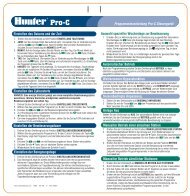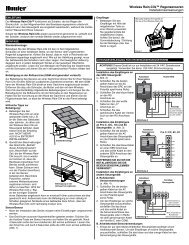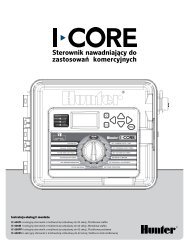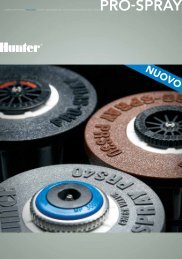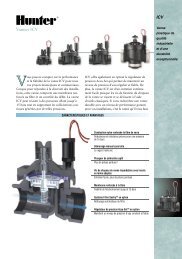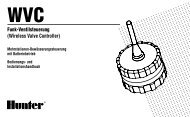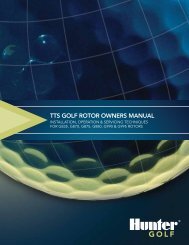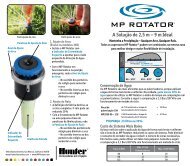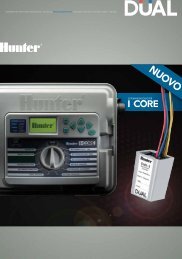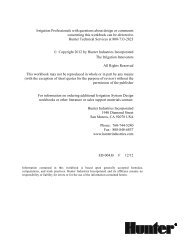Decoder Design Guide - Hunter Industries
Decoder Design Guide - Hunter Industries
Decoder Design Guide - Hunter Industries
You also want an ePaper? Increase the reach of your titles
YUMPU automatically turns print PDFs into web optimized ePapers that Google loves.
DESIGN GUIDE<br />
Using pre-existing wire: This is strongly discouraged by <strong>Hunter</strong> for the following reasons:<br />
• It is unlikely that the pre-existing wire meets the specifications for gauge, twist, and solid copper<br />
• Pre-existing wire will not be color-coded correctly for the decoder wires<br />
• Pre-existing wire may have invisible problems (shorts, breaks, increased resistance, or damaged insulation) that will be<br />
inherited by the new installation<br />
It is unwise to take chances on large projects by trying to "beat" wire specifications.<br />
Wire Connectors<br />
All connections and splices in the red/blue two-wire path (IDWIRE) must be made with<br />
DBRY-6 or equal waterproof connectors.<br />
• All <strong>Hunter</strong> decoders are now supplied with DBRY-6 connectors<br />
• All "-6" connectors are rated to 600V direct burial and have high temperature<br />
resistance<br />
• Additional splices and connections in the two-wire path must be made with<br />
equivalent connectors<br />
Whenever a splice or connection is made, it is important to leave adequate slack in<br />
the wires. Leave 5 ft/1.5 m slack to prevent contraction of the wire from damaging the<br />
connections, and to allow the splices to be removed from the valve box for service<br />
or inspection.<br />
Wire slack may be coiled neatly or around the inside of the valve box.<br />
<strong>Decoder</strong>-to-Solenoid connections may be made with standard DBY or equal waterproof<br />
connectors. These require only 30V or similar ratings but still require slack and strain relief.<br />
Waterproof Connectors<br />
"T" Splicing <strong>Decoder</strong> Wire<br />
Wire slack for service<br />
• It is permissible to T-splice decoder wire paths<br />
• All T-splices must be made in valve boxes with DBRY-6 or equal connectors<br />
• T-splices consist of making a three way connection in the red wire, and a three way<br />
connection in the blue wire<br />
• It is especially important to allow adequate slack in a three-way splice. Each splice<br />
should be able to be withdrawn from the valve box for above-ground inspection<br />
and service.<br />
Where possible, it is desirable to run the two-wire paths in the same trenches as<br />
irrigation pipe. The pipe will provide some protection to the wire, and logically leads<br />
to the valves where decoders will be positioned (see illustration).<br />
The maximum run of a given wire type is valid from the controller to the end of each arm<br />
of the T.<br />
If the total distance from the controller to the end of each arm of the T is under 10,000 ft/3<br />
km (using ID1 wires as an example), the system meets specification, even if the total amount<br />
of wire exceeds 10,000 ft/3 km.<br />
Wire Slack for Service<br />
For example (using the more common 14 AWG/2.5 mm 2 ID1 wires), if a T is placed 5,000 ft/1.5 km from the controller, and 2 arms<br />
in different directions each run an additional 5,000 ft/1.5 km, the wire is within specifications. It is only 10,000 ft/3 km to the end<br />
of each arm of the T from the controller, even though there is 15,000 ft/4.5 km total wire connected to the output.<br />
It is possible to have more than one splice in a wire run, provided all the above conditions are met. With DUAL systems, the<br />
distances differ but the same principles apply.<br />
<strong>Decoder</strong> Systems <strong>Design</strong> <strong>Guide</strong> • Page 5 • www.hunterindustries.com



